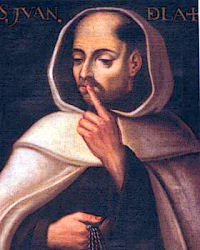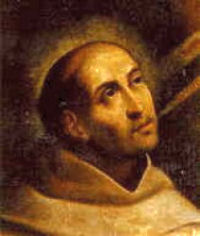Advent: December 14th
Memorial of St. John of the Cross, Priest and Doctor; Ember Wednesday
» Enjoy our Liturgical Seasons series of e-books!
Today the Church celebrates the Memorial of St. John of the Cross (1542-1591). He was born and died in Spain. His parents were poor and could not give him training in any trade, hence he became the servant of the sick in the hospital of Medina. In 1563 he offered himself as a lay brother to the Carmelite friars, who, however, perceiving his unusual talents, had him ordained a priest. When he was about to join the more severe Order of the Carthusians, St. Teresa of Avila persuaded him to remain and help her in the reform of the Carmelite Order. This reform of his order caused him such sufferings and brought him many trials. But his sufferings served only to detach him from creatures. He had a great devotion to Our Lord's Passion and voluntarily sought out humiliations. When Our Lord asked him what reward he would ask for his labors, John answered: "To suffer and to be despised for Thee." He died of a very painful disease, erysipelas, while embracing the crucifix. Because of his profound treatises on mystical theology Pope Pius XI proclaimed him Doctor of the Church in 1926.
![]()
Station Church Information >>>![]()
December Ember Days or Advent Embertide, Ember Wednesday Shortly after Gaudete Sunday and St. Lucy’s feast day on December 13 the Advent Ember Days begin. Today is the traditional Ember Wednesday, which marks the beginning of Advent Embertide. The Ember days represent an ancient and cherished tradition of the Roman Church. Four times a year, at the change of seasons, three days of the week, Wednesday, Friday and Saturday, were devoted to prayer and fasting to call down God's blessing on the new season and on the ordinations which took place during the vigil held on the Saturday-Sunday night.
The Ember Days are no longer universally marked on the General Roman Calendar, but are practiced according to the local ordinary. In the 1969 Calendar reform (see General Instruction on the Roman Missal), the observance of Ember Days was left to the discretion of the local conference of bishops, and can be adjusted and expanded. In the USA it is mainly the rural areas that the bishops choose to officially observe Ember Days, but in other countries they are observed. While Ember Days are not part of the whole community worship, personal observance at home or small communities is not discouraged.
Advent, which is of more recent institution in the development of the Liturgical Year, has endowed the December Ember days with their special character of expectation and preparation for Christmas, thus reducing the idea of fasting and penance to a secondary position.
Advent Embertide marked four different themes:
- Thanksgiving for the Harvest: Traditionally the Advent Ember Days marked thanksgiving for the olive harvest. Olive oil is used for the Holy Oils in the sacraments of Baptism, Confirmation and Anointing of the Sick, and also for special consecrations and blessings, such as for a new church or altar stone. The thanksgiving emphasis was expressed on Ember Wednesday, with offering of first fruits and distribution of blessed food baskets for the needy.
- Days of Spiritual Renewal: Holy Mother Church provides us so many opportunities to redirect, refresh and renew. Our human frailty needs reminders to resolve to start anew. These three days are opportunities to add extra prayer and penance for ourselves and others.
- Praying for Priests: For centuries this Ember Saturday was the only day in the Church's year for conferring the sacrament of Holy Orders. The Church no longer regularly ordains priests during the times of the Quarterly Ember Days, but this is a special time, particularly Ember Saturday, to pray for priests, particularly the ones who are about to be ordained within the year.
- Reflecting the Spirit of the Season: Each set of Ember Days reflect the season of the Liturgical Year in which they occur. The Advent Ember Days fall near the end of Advent, and the traditional liturgy summarizes the weeks of longing for the Messiah. The Masses include the Messianic prophecies regarding Christ’s Birth and Epiphany in order to prepare for Christmas. The 1962 liturgy had Ember Wednesday’s Gospel focused on the Incarnation, Ember Friday presented St. Elizabeth and the Visitation of Mary, and Ember Saturday featured St. John the Baptist.
Of particular note is the ancient liturgy of Missa Aurea or “Golden Mass” on Ember Wednesday. On this day the Church celebrated the “golden mystery” of our Faith, the moment the Word became flesh, the Incarnation of Christ in Mary’s womb. In the current Roman Missal, the Golden Mass is not lost but celebrated in the liturgy on December 20, the O Antiphon day “O Key of David.”
The Stational churches were part of the Ember Days, with Ember Wednesdays always being with Mary, Station with Santa Maria Maggiore (St. Mary Major).
—adapted from Saint Andrew Daily Missal, Pius Parsch, OSB, The Church's Year of Grace and Benedict Baur, The Light of the World
![]()
Jesse Tree, Day 18 ~ Elijah
Jesse Tree Overview![]()
St. John of the Cross
 Juan de Yepes was the Castilian son of a poor silk weaver of Fontiberos, Toledo, Spain and was born in 1542. His father was of noble birth; he had married much beneath him, and for that offense had been entirely cut off by his family. He had taken to silk weaving as a means of livelihood, but had never been able to make much of it. Soon after the birth of Juan he died, worn out with the effort to keep his wife and three children. The family was left in direst poverty; the children grew up always underfed, so that to the end of his life Juan remained dwarfed in stature.
Juan de Yepes was the Castilian son of a poor silk weaver of Fontiberos, Toledo, Spain and was born in 1542. His father was of noble birth; he had married much beneath him, and for that offense had been entirely cut off by his family. He had taken to silk weaving as a means of livelihood, but had never been able to make much of it. Soon after the birth of Juan he died, worn out with the effort to keep his wife and three children. The family was left in direst poverty; the children grew up always underfed, so that to the end of his life Juan remained dwarfed in stature.
Unable to learn a trade, he became the servant of the poor in the hospital of Medina, while still pursuing his sacred studies. In 1563, being then twenty-one, he humbly offered himself as a lay-brother to the Carmelite friars, who, however, knowing his talents, had him ordained priest. He would now have exchanged to the severe Carthusian Order, had not St. Teresa of Avila, with the instinct of a saint, persuaded him to remain and help her in the reform of his own Order.
Thus he became the first prior of the Discalced (meaning "barefoot") Carmelites. His reform, though approved by the general, was rejected by the elder friars, who condemned the saint as a fugitive and apostate, and cast him into prison, whence he only escaped, after nine months' suffering, at the risk of his life. Twice again, before his death, he was shamefully persecuted by his brethren, and publicly disgraced. But his complete abandonment by creatures only deepened his interior peace and devout longing for heaven.
St. John was a great contemplative and spiritual writer. He was proclaimed Doctor of the Church by Pope Pius XI on August 24, 1926. He is the patron of contemplative life, mystical theology, mystics, and Spanish poets.
—Excerpted from Little Pictorial Lives of the Saints ©1878 and Saints for Sinners by Alban Goodier, S.J.
"With what procrastinations do you wait, since from this very moment you can love God in your heart?"
—Excerpted from Prayer of a Soul Taken with Love — St. John of the CrossMine are the heavens and mine is the earth. Mine are the nations, the just are mine and mine the sinners. The angels are mine, and the Mother of God, and all things are mine; and God himself is mine and for me, because Christ is mine and all for me. What do you ask, then, and seek my soul? Yours is all of this, and all is for you. Do not engage your self in something less or pay heed to the crumbs that fall from your Father's table. Go forth and exult in your Glory! Hide yourself in it and rejoice, and you will obtain the supplications of your heart.
—Excerpted from Sayings of Light and Love, 26-27 —St. John of the Cross
Patronage: Contemplative life; contemplatives; mystical theology; mystics; Spanish poets; Segovia, Spain; Ta’ Xbiex, Malta
Symbols and Representation: eagle; priest in Carmelite robes holding a cross
Highlights and Things to Do:
- See Celebrating the Feast of St. John of the Cross for ideas.
- Read more about St. John of the Cross at the ICS website.
- Three of his works, Ascent of Mount Carmel, Dark Night of the Soul and Spiritual Canticle of the Soul and the Bridegroom Christ are available online at the Christian Classics Ethereal Library.
- Learn more about St. John of the Cross:






